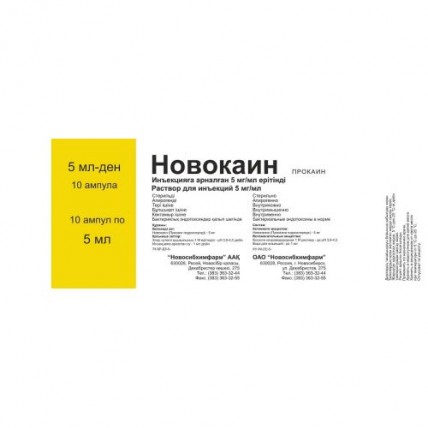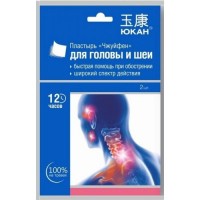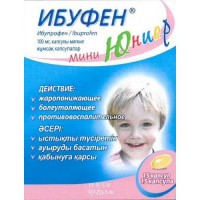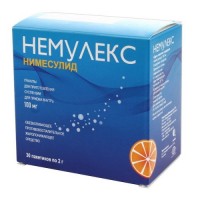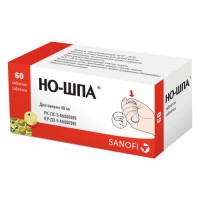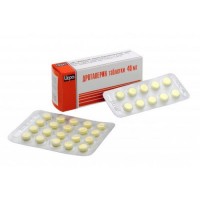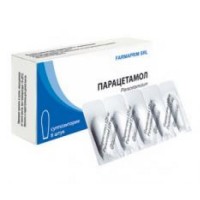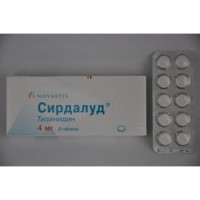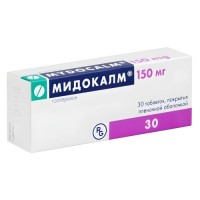Novocaine 0,5% / 5 ml 10s solution for injection in ampoules
- $2.70
The instruction
for medical use of medicine
Novocaine
the Trade name
Novocaine
the International unlicensed
name Procainum Dosage Form Solution for injections of 5 mg/ml, 5 ml
Structure
of 1 ml of solution contains
active agent - novocaine (Procainum a hydrochloride) 5.0 mg
excipients - acid of chlorohydrogen 1 M solution to rn 3.8-4.5, water for injections
the Description
the Transparent, colourless or slightly painted liquid
Pharmacotherapeutic group
Anesthetics. Local anesthetics. Aminobenzoic acid ethers. Procainum.
The ATX NO1BA02 code
the Pharmacological
Pharmacokinetics At properties parenteral administration is well soaked up, quickly hydrolyzed by esterases of plasma and a liver with education of two main pharmacological active metabolites: diethylaminoethanol (possesses moderate vasodilating action) and para-aminobenzoic acid (is a competitive antagonist of sulfanamide drugs and can weaken their antimicrobial action). Elimination half-life (T1/2) makes 0.7 min. It is removed mainly by kidneys in the form of metabolites (80%).
A pharmacodynamics
Mestnoanesteziruyushy means with the moderate anesthetizing activity and big width of therapeutic action. Being the weak basis, blocks natrium channels, forces out calcium from the receptors located on an internal surface of a membrane and thus interferes with generation of impulses in nerve terminations and to carrying out impulses on nerve fibrils. Changes action potential in membranes of neurons without the significant influence on rest potential. Suppresses carrying out not only painful, but also impulses of other modality. Has the short anesthetizing activity (duration of infiltration anesthesia is 0.5-1 h). At absorption in a system blood stream and direct vascular introduction can reduce excitability of peripheral cholinergic systems, reduce education and release of acetylcholine from the preganglionic terminations (possesses some ganglioblokiruyushchy action), to eliminate a spasm of smooth muscles, to reduce excitability of a myocardium and motor zones of a cerebral cortex. At intravenous administration renders analgeziruyushchy, antishock, hypotensive and antiarrhytmic action (increases the effective refractory period, reduces excitability, automatism and conductivity), in high doses can break neuromuscular conductivity. Eliminates the descending brake influences of a reticular formation of a brainstem. Oppresses polisinaptichesky reflexes. In high doses can cause spasms.
Indications
- infiltration (including intra bone) anesthesia
- for carrying out blockade (vagosympathetic cervical, perinephric, circular and juxtaspinal).
The route of administration and doses
the Dose and concentration of solution of Procainum depend on the nature of surgery, a route of administration, a state and age of the patient.
For infiltration anesthesia 0.25-0.5% solutions, are applied to anesthesia by Vishnevsky's method (hard creeping infiltration) - 0.125-0.25% solutions.
The highest doses for infiltration anesthesia for adults: the first single
dose at the beginning of operation - is not higher than 1.0 g of 0.25% of solution and 0.75 g of 0.5% of solution (150 ml). Further, for each 1 hour of operation - it is not higher than 2.5 g when using of 0.25% of solution (1000 ml) and 2.0 g at use of 0.5% of solution (400 ml).
At perinephric blockade (according to A.V. Vishnevsky) enter 50-80 ml of 0.5% of solution or 100-150 ml of 0.25% of solution into pararenal cellulose.
At vagosympathetic blockade - 30-100 ml of 0.25% of solution.
For reduction of absorption and lengthening of action at local anesthesia
in addition enter 0.1% hydrochloride epinephrine solution - on 1 drop on 2-5-10 ml of solution of Procainum.
The maximum dose for use for children is more senior than 12 years no more than 15 mg/kg.
Side effects
from the central and peripheral nervous system: a headache, dizziness, drowsiness, weakness, motive concern, a loss of consciousness, a tremor, spasms, visual and acoustical disturbances, a nystagmus, a syndrome of a horse tail (paralysis of legs, paresthesias), paralysis of respiratory muscles, the block motor and sensitive
from a cardiovascular system: increase or a lowering of arterial pressure, a peripheral vazodilatation, collapse, bradycardia, arrhythmias, thorax pain
from digestive system: nausea, vomiting, involuntary defecation
from an urinary system: involuntary urination
from blood: methemoglobinemia
Allergic reactions: urticaria, an itching, an erythema, a Quincke's disease (including a laryngeal edema), anaphylactic reactions (including an acute anaphylaxis).
Other: return of pain, resistant anesthesia, a hypothermia, erectile dysfunction, a hypothermia at anesthesia in stomatology: the insensitivity and paresthesias of lips and language, a lockjaw
If at use of drug appeared any of the side effects specified in the instruction either they are aggravated, or you noticed any other side effects which are not specified in the instruction, report about it to the doctor.
Contraindications
- hypersensitivity to Procainum (including to para-aminobenzoic acid and other local Anesthetics Ether) and to drug components
- children's age (up to 12 years)
- the significant fibrous changes in fabrics (for anesthesia by method of creeping infiltrate).
- a myasthenia
- arterial hypotension
- purulent process in the injection site
- the immediate surgeries which are followed by sharp blood loss
Medicinal interactions
Local anesthetics strengthen the oppressing action on the central nervous system (CNS) of other medicines.
Anticoagulants (ardeparin, dalteparin, danaparoid, enoksaparin, heparin, warfarin) at combined use with novocaine increase risk of developing bleedings.
When processing the place of an injection of novocaine the disinfecting solutions containing salts of heavy metals risk of development of local reaction in the form of morbidity and hypostasis increases.
Use of novocaine with monoamine oxidase inhibitors (furasolidone, Procarbazinum, selegilin) increases risk of developing hypotension therefore they should be cancelled in 10 days prior to use of local anesthetic.
Novocaine strengthens and extends effect of myorelaxation medicines.
When prescribing novocaine together with narcotic analgetics the additive effect is noted that is used when carrying out spinal and epidural anesthesia, at the same time respiratory depression amplifies.
Vasoconstrictors (epinephrine, metoksamin, Phenylephrinum) extend mestnoanesteziruyushchy effect of novocaine.
Novocaine reduces anti-myasthenic effect of medicines, especially at its use in high doses that demands additional correction of treatment of a myasthenia.
Cholinesterase inhibitors (anti-myasthenic medicines, cyclophosphamide, demekarin, ecothioveils, Thiotepum) reduce Procainum metabolism.
Procainum metabolite (para-aminobenzoic acid) is a competitive antagonist of streptocides and can weaken their antimicrobial action therefore use of these drugs
at the same time Special instructions
With care is not recommended it is necessary to appoint drug at the immediate surgeries which are followed by sharp blood loss, the states which are followed by decrease in a hepatic blood-groove (for example, in chronic heart failure, liver diseases), progressing of cardiovascular insufficiency (usually owing ment of heart blocks and shock), deficiency of pseudo-cholinesterase, a renal failure, inflammatory diseases or infection of the place of an injection.
At use of novocaine for children (from 12 to 18 years), elderly (65 years are more senior), seriously ill patients and the weakened faces it is necessary to be careful.
High plasma concentration which can be observed owing to overdose, fast system absorption, inadvertent intravascular introduction or slow metabolic degradation is a basic reason of development of undesirable reactions at use of Procainum. Besides, decrease in tolerance, including owing to deficiency of cholinesterase in plasma of blood, existence of the factors influencing communication with proteins of plasma, such as acidosis, the associated diseases leading to a hypoalbuminemia, the competition to other medicines for communication with proteins of plasma can lead to increase in plasma concentration of Procainum. In this regard when carrying out anesthesia it is necessary to exercise control of the vital functions of an organism.
Before use conducting tests on individual sensitivity to drug is obligatory. It is necessary to consider concentration of solution when carrying out local anesthesia (when using the same general dose, the toxicity of Procainum can be different depending on concentration of solution). It is not soaked up from mucous membranes and does not provide surface anesthesia at skin use.
It is necessary to appoint pregnancy and the period of a lactation with care and according to absolute indications, after assessment of a ratio of expected advantage for mother and potential risk for a fruit or
the child Osobennosti of influence of medicine on ability to run the vehicle or potentially dangerous mechanisms
during treatment it is necessary to be careful when driving
by transport or potentially dangerous types of activity demanding the increased concentration of attention and speed
of psychomotor reactions.
Overdose
Symptoms: pallor of integuments and mucous membranes, 'cold' sweat, excitement or oppression of central nervous system, concern, alarm, dizziness, sonitus, illegibility of visual perception, tremor, spasms, oppression of function of a myocardium, decrease in warm emission, heart block, decrease or sometimes increase in arterial blood pressure, bradycardia, ventricular arrhythmia, cardiac arrest, methemoglobinemia.
Treatment: maintenance of adequate lung ventilation with oxygen inhalation, disintoxication and symptomatic therapy.
A form of release and packing
On 5 ml in ampoules from neutral glass.
On 10 ampoules place in a box of cardboard. Put the instruction for medical use in each box in the state and Russian languages and a knife for opening of ampoules or the scarificator ampoule.
On 5 or 10 ampoules place in blister strip packaging from a film polyvinylchloride.
On 1 (on 10 ampoules) or 2 (on 5 ampoules) blister strip packagings with the instruction for medical use in the state and Russian languages and a knife for opening of ampoules or the scarificator ampoule place in a pack from cardboard.
When packing ampoules with a ring of a break or a point of a break the knife for opening of ampoules or the scarificator ampoule is not put.
To Store storage conditions in the place protected from light at a temperature from 5 °C to 25 °C.
To store out of children's reach!
3 years
not to use a period of storage after the expiration date specified on packing.
Prescription status
According to the prescription
JSC Novosibkhimfarm Producer 630028, Russia, Novosibirsk, Dekabristov St., 275
ph. (383) 363-32-44, fax (383) 363-32-55
Owner of the registration certificate:
JSC Novosibkhimfarm
630028, Russia, Novosibirsk, Dekabristov St., 275
ph. (383) 363-32-44, fax (383) 363-32-55
The address of the organization accepting claims for territories of the Republic of Kazakhstan from consumers on quality of products (goods)
of Valenta Aziya LLP, Almaty, the ave. of Abay, ug. Radostovts St., 151/115, business center "Ala Tau"
office No. 1102 Ph./fax 8727,334-15-52, E-mail:
asia@valentapharm.com
for medical use of medicine
Novocaine
the Trade name
Novocaine
the International unlicensed
name Procainum Dosage Form Solution for injections of 5 mg/ml, 5 ml
Structure
of 1 ml of solution contains
active agent - novocaine (Procainum a hydrochloride) 5.0 mg
excipients - acid of chlorohydrogen 1 M solution to rn 3.8-4.5, water for injections
the Description
the Transparent, colourless or slightly painted liquid
Pharmacotherapeutic group
Anesthetics. Local anesthetics. Aminobenzoic acid ethers. Procainum.
The ATX NO1BA02 code
the Pharmacological
Pharmacokinetics At properties parenteral administration is well soaked up, quickly hydrolyzed by esterases of plasma and a liver with education of two main pharmacological active metabolites: diethylaminoethanol (possesses moderate vasodilating action) and para-aminobenzoic acid (is a competitive antagonist of sulfanamide drugs and can weaken their antimicrobial action). Elimination half-life (T1/2) makes 0.7 min. It is removed mainly by kidneys in the form of metabolites (80%).
A pharmacodynamics
Mestnoanesteziruyushy means with the moderate anesthetizing activity and big width of therapeutic action. Being the weak basis, blocks natrium channels, forces out calcium from the receptors located on an internal surface of a membrane and thus interferes with generation of impulses in nerve terminations and to carrying out impulses on nerve fibrils. Changes action potential in membranes of neurons without the significant influence on rest potential. Suppresses carrying out not only painful, but also impulses of other modality. Has the short anesthetizing activity (duration of infiltration anesthesia is 0.5-1 h). At absorption in a system blood stream and direct vascular introduction can reduce excitability of peripheral cholinergic systems, reduce education and release of acetylcholine from the preganglionic terminations (possesses some ganglioblokiruyushchy action), to eliminate a spasm of smooth muscles, to reduce excitability of a myocardium and motor zones of a cerebral cortex. At intravenous administration renders analgeziruyushchy, antishock, hypotensive and antiarrhytmic action (increases the effective refractory period, reduces excitability, automatism and conductivity), in high doses can break neuromuscular conductivity. Eliminates the descending brake influences of a reticular formation of a brainstem. Oppresses polisinaptichesky reflexes. In high doses can cause spasms.
Indications
- infiltration (including intra bone) anesthesia
- for carrying out blockade (vagosympathetic cervical, perinephric, circular and juxtaspinal).
The route of administration and doses
the Dose and concentration of solution of Procainum depend on the nature of surgery, a route of administration, a state and age of the patient.
For infiltration anesthesia 0.25-0.5% solutions, are applied to anesthesia by Vishnevsky's method (hard creeping infiltration) - 0.125-0.25% solutions.
The highest doses for infiltration anesthesia for adults: the first single
dose at the beginning of operation - is not higher than 1.0 g of 0.25% of solution and 0.75 g of 0.5% of solution (150 ml). Further, for each 1 hour of operation - it is not higher than 2.5 g when using of 0.25% of solution (1000 ml) and 2.0 g at use of 0.5% of solution (400 ml).
At perinephric blockade (according to A.V. Vishnevsky) enter 50-80 ml of 0.5% of solution or 100-150 ml of 0.25% of solution into pararenal cellulose.
At vagosympathetic blockade - 30-100 ml of 0.25% of solution.
For reduction of absorption and lengthening of action at local anesthesia
in addition enter 0.1% hydrochloride epinephrine solution - on 1 drop on 2-5-10 ml of solution of Procainum.
The maximum dose for use for children is more senior than 12 years no more than 15 mg/kg.
Side effects
from the central and peripheral nervous system: a headache, dizziness, drowsiness, weakness, motive concern, a loss of consciousness, a tremor, spasms, visual and acoustical disturbances, a nystagmus, a syndrome of a horse tail (paralysis of legs, paresthesias), paralysis of respiratory muscles, the block motor and sensitive
from a cardiovascular system: increase or a lowering of arterial pressure, a peripheral vazodilatation, collapse, bradycardia, arrhythmias, thorax pain
from digestive system: nausea, vomiting, involuntary defecation
from an urinary system: involuntary urination
from blood: methemoglobinemia
Allergic reactions: urticaria, an itching, an erythema, a Quincke's disease (including a laryngeal edema), anaphylactic reactions (including an acute anaphylaxis).
Other: return of pain, resistant anesthesia, a hypothermia, erectile dysfunction, a hypothermia at anesthesia in stomatology: the insensitivity and paresthesias of lips and language, a lockjaw
If at use of drug appeared any of the side effects specified in the instruction either they are aggravated, or you noticed any other side effects which are not specified in the instruction, report about it to the doctor.
Contraindications
- hypersensitivity to Procainum (including to para-aminobenzoic acid and other local Anesthetics Ether) and to drug components
- children's age (up to 12 years)
- the significant fibrous changes in fabrics (for anesthesia by method of creeping infiltrate).
- a myasthenia
- arterial hypotension
- purulent process in the injection site
- the immediate surgeries which are followed by sharp blood loss
Medicinal interactions
Local anesthetics strengthen the oppressing action on the central nervous system (CNS) of other medicines.
Anticoagulants (ardeparin, dalteparin, danaparoid, enoksaparin, heparin, warfarin) at combined use with novocaine increase risk of developing bleedings.
When processing the place of an injection of novocaine the disinfecting solutions containing salts of heavy metals risk of development of local reaction in the form of morbidity and hypostasis increases.
Use of novocaine with monoamine oxidase inhibitors (furasolidone, Procarbazinum, selegilin) increases risk of developing hypotension therefore they should be cancelled in 10 days prior to use of local anesthetic.
Novocaine strengthens and extends effect of myorelaxation medicines.
When prescribing novocaine together with narcotic analgetics the additive effect is noted that is used when carrying out spinal and epidural anesthesia, at the same time respiratory depression amplifies.
Vasoconstrictors (epinephrine, metoksamin, Phenylephrinum) extend mestnoanesteziruyushchy effect of novocaine.
Novocaine reduces anti-myasthenic effect of medicines, especially at its use in high doses that demands additional correction of treatment of a myasthenia.
Cholinesterase inhibitors (anti-myasthenic medicines, cyclophosphamide, demekarin, ecothioveils, Thiotepum) reduce Procainum metabolism.
Procainum metabolite (para-aminobenzoic acid) is a competitive antagonist of streptocides and can weaken their antimicrobial action therefore use of these drugs
at the same time Special instructions
With care is not recommended it is necessary to appoint drug at the immediate surgeries which are followed by sharp blood loss, the states which are followed by decrease in a hepatic blood-groove (for example, in chronic heart failure, liver diseases), progressing of cardiovascular insufficiency (usually owing ment of heart blocks and shock), deficiency of pseudo-cholinesterase, a renal failure, inflammatory diseases or infection of the place of an injection.
At use of novocaine for children (from 12 to 18 years), elderly (65 years are more senior), seriously ill patients and the weakened faces it is necessary to be careful.
High plasma concentration which can be observed owing to overdose, fast system absorption, inadvertent intravascular introduction or slow metabolic degradation is a basic reason of development of undesirable reactions at use of Procainum. Besides, decrease in tolerance, including owing to deficiency of cholinesterase in plasma of blood, existence of the factors influencing communication with proteins of plasma, such as acidosis, the associated diseases leading to a hypoalbuminemia, the competition to other medicines for communication with proteins of plasma can lead to increase in plasma concentration of Procainum. In this regard when carrying out anesthesia it is necessary to exercise control of the vital functions of an organism.
Before use conducting tests on individual sensitivity to drug is obligatory. It is necessary to consider concentration of solution when carrying out local anesthesia (when using the same general dose, the toxicity of Procainum can be different depending on concentration of solution). It is not soaked up from mucous membranes and does not provide surface anesthesia at skin use.
It is necessary to appoint pregnancy and the period of a lactation with care and according to absolute indications, after assessment of a ratio of expected advantage for mother and potential risk for a fruit or
the child Osobennosti of influence of medicine on ability to run the vehicle or potentially dangerous mechanisms
during treatment it is necessary to be careful when driving
by transport or potentially dangerous types of activity demanding the increased concentration of attention and speed
of psychomotor reactions.
Overdose
Symptoms: pallor of integuments and mucous membranes, 'cold' sweat, excitement or oppression of central nervous system, concern, alarm, dizziness, sonitus, illegibility of visual perception, tremor, spasms, oppression of function of a myocardium, decrease in warm emission, heart block, decrease or sometimes increase in arterial blood pressure, bradycardia, ventricular arrhythmia, cardiac arrest, methemoglobinemia.
Treatment: maintenance of adequate lung ventilation with oxygen inhalation, disintoxication and symptomatic therapy.
A form of release and packing
On 5 ml in ampoules from neutral glass.
On 10 ampoules place in a box of cardboard. Put the instruction for medical use in each box in the state and Russian languages and a knife for opening of ampoules or the scarificator ampoule.
On 5 or 10 ampoules place in blister strip packaging from a film polyvinylchloride.
On 1 (on 10 ampoules) or 2 (on 5 ampoules) blister strip packagings with the instruction for medical use in the state and Russian languages and a knife for opening of ampoules or the scarificator ampoule place in a pack from cardboard.
When packing ampoules with a ring of a break or a point of a break the knife for opening of ampoules or the scarificator ampoule is not put.
To Store storage conditions in the place protected from light at a temperature from 5 °C to 25 °C.
To store out of children's reach!
3 years
not to use a period of storage after the expiration date specified on packing.
Prescription status
According to the prescription
JSC Novosibkhimfarm Producer 630028, Russia, Novosibirsk, Dekabristov St., 275
ph. (383) 363-32-44, fax (383) 363-32-55
Owner of the registration certificate:
JSC Novosibkhimfarm
630028, Russia, Novosibirsk, Dekabristov St., 275
ph. (383) 363-32-44, fax (383) 363-32-55
The address of the organization accepting claims for territories of the Republic of Kazakhstan from consumers on quality of products (goods)
of Valenta Aziya LLP, Almaty, the ave. of Abay, ug. Radostovts St., 151/115, business center "Ala Tau"
office No. 1102 Ph./fax 8727,334-15-52, E-mail:
asia@valentapharm.com
